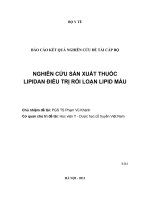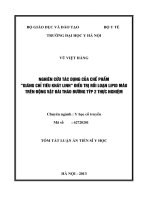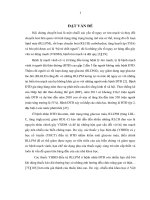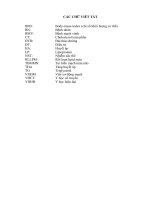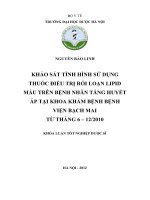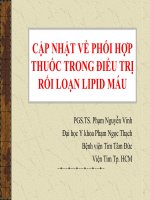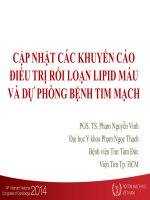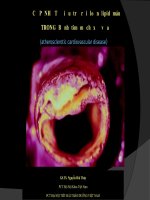Cập nhật điều trị Rối loạn Lipid máu năm 2016
Bạn đang xem bản rút gọn của tài liệu. Xem và tải ngay bản đầy đủ của tài liệu tại đây (4.5 MB, 44 trang )
Dyslipidemia
Management in 2016
Michael Heffernan
MD PhD FRCPC FACC
Faculty/Presenter
Disclosure
• Faculty:
Dr.
Michael
Heffernan
• Title
of
Talk:
2016
Dyslipidemia
Update
• Relationships
with
commercial
interests:
• Grants/Research
Support:
Bayer,
Boehringer
Ingelheim,
Esai,
AstraZeneca
• Speakers
Bureau/Honoraria:
AstraZeneca,
Bayer,
Boehringer
Ingelheim,
Bristol
Myers
Squibb,
Pfizer,
Amgen,
Servier,
Sanofi
• Consulting
Fees:
Bayer,
AstraZeneca,
Boehringer
Ingelheim,
Amgen,
Sanofi
• Other:
None
Objectives
At
the
end
of
this
presentation,
the
participant
will
be
able
to:
Identify patients not at LDL-C goal despite current treatment
and discuss why they would benefit from further LDL-C
reduction
Appraise clinical data and new treatment strategies to lower
LDL-C in the high risk patient
Discuss clinical management of the high risk patient not at
goal and implementation of new treatment strategies
The Case: John
56y
male
HTN,
dyslipidemia
Previous
MI
and
angioplasty
at
age
48y
Family
history
of
premature
CAD
Non-‐smoker
Exercises
100
min/week
ALended
cardiac
rehab
and
adheres
to
dietary
guidelines
The Case
Medica'ons
− ASA
81
mg
once
daily
− AtorvastaOn
20
mg
− Bisoprolol
5
mg
once
daily
− Ramipril
10
mg
once
daily
Lipid
Profile
− TC:
5.9
mmol/L
− TG:1.4
mmol/L
− HDL-‐C:
1.4
mmol/L
− LDL-‐C:
3.6
mmol/L
(current)
− non-‐HDL-‐C:
4.3
mmol/L
− He
has
tried
rosuvastaOn
but
was
unable
to
tolerate
it
(mylagias)
− He
was
on
40
mg
of
atorvastaOn
however
this
also
provoked
myalgias
− He
can
tolerate
20
mg
of
atorvastaOn
What is John’s Target and Why Do We
Want to Get Him There ?
The Cholesterol Hypothesis Originated
with Observational Studies
Epidemiologic Data – Serum Cholesterol Levels and CHD
MRFIT trial: age-adjusted CHD death rate and serum cholesterol in 361,662 US
men (aged 35–57 years)
Each 1% Increase in Total
Cholesterol Level is associated with
a 2% Increase in CHD Risk
Martin MJ, et al. Lancet 1986;2:933–936
8
Clinical Trials Validated The LDL
Hypothesis
30
These trials have demonstrated that
LDL-C lowering is associated with
greater reduction of CHD events
CHD Event Rate,%
25
Secondary Prevention
4S-P
20
4S-T
15
1O
DIABETES
PREVENTION
Care-P
Care-T
10
HPS-T
PROS-T
TNT-80
TNT-10
Ascot-T
JUP-T
0
1.3
1.8
Lipid-T
HPS-P
PROS-P
WPS-P
AFCAPS-P
CARDS-T
5
Lipid-P
2.5
Primary Prevention
JUP-P AFCAPS-T
WPS-T
Ascot-P
3.0
3.5
4.0
LDL-C mmol/L
4.5
5.0
5.4
@>4'(.:(24'$*2(&:%(8:$*2/&'/.:.[$Y@**Z$@4''&M42&O48T$V&8G(:T$PIHI\X]"SH"]ICH"
W2_94/2($^,$(:$&'T$@&8$^$@&2-/4'T$PIH;\XIY;ZSX]]C<I\$A-&0:(-$?24%$W4L4$A$^2,$`0/($V)T$B259.$?42$:>($)(&2:T$]:>$(-T$1>/'&-('0>/&S$E'.(3/(2$N&58-(2.T$PIIUSX!XT$
Amount of LDL-C Reduction is Associated
with Proportional Reduction in CV Events
Proportional reduction in event rate (SE)
50%
40%
30%
20%
10%
0%
1.0
0.5
1.5
Reduction in LDL cholesterol (mmol/L)
-10%
HT!
PT!
XT!
@>4'(.:(24'$*2(&:%(8:$*2/&'/.:.[$@4''&M42&O48T$V&8G(:T$PII!\X""SHP"]CHP]
2.0
The IMPROVE-IT Study
100
Simvastatin
Mean LDL-C (mg/dL)
90
Simvastatin + Ezetimibe
80
1.8 mmol/L
70
60
1.4 mmol/L
50
40
QE
R
1
2
8
12
16
24
36
48
60
72
Time since randomization (months)
761R`aEC7*$783(.O9&:42.T$+$E89'$^$6(-T$PIH!\X]PYP!ZSPX<]CU]T
84
96
Effect of Lower LDL-C on the Risk of CHD Appears
to be Independent of the Mechanism by which
LDL-C is Lowered
More LDL lowering
and risk reduction
Reduction in Cardiovascular Events (%)
50
40
Ezetimibe
Fibrate
Bile acid resin
30
Niacin
Diet/unsat. Fatty acid
20
Ileal bypass
CTTC trials (statin)
10
IMPROVE-IT
0
0.3
0.5
0.8
1.0
1.3
1.5
Reduction in LDL-C (mmol/L)
1.8
2.1
Non-statin lipid-lowering studies suggest coronary event reduction is due to
LDL-C reduction, independent of method
@>4'(.:(24'$*2(&:%(8:$*2/&'/.:.[$@4''&M42&O48T$V&8G(:T$PII!\X""SHP"]CHP]<\$*>($@4248&2#$B259$124b(G:$R(.(&2G>$W2450T$^A6AT$HU]!\PXHSX"IcX
Change in Progression of IVUS Percent
Atheroma Volume versus LDL-C in IVUS Trials
1.8"
CAMELOT
placebo
1.2"
Median
Change 0.6"
In Percent
Atheroma
0"
Volume
(%)
REVERSAL
atorvastatin
-0.6"
-1.2"
1.3"
ACTIVATE
placebo
A-Plus
placebo
r2= 0.95
p<0.001
ASTEROID
rosuvastatin"
1.5"
JAMA 2006; 295:1556-1565
Cleve Clin J Med 2006;73:937-944
1.8"
REVERSAL
pravastatin
2.1"
2.3"
2.6"
On-Treatment LDL-C (mmol/L)
2.8"
3.1"
Summary: The LDL Hypothesis
Epidemiologic data indicates a direct relationship
between total cholesterol levels and CV outcomes
Clinical trials to date indicate that decrease in total
cholesterol or LDL-C with statin therapy or other
measures leads to a proportionate decrease in CV
outcomes
The IMPROVE-IT trial has reaffirmed the lipid hypothesis
by demonstrating that non-statin therapy can achieve an
LDL-C decrease that translates into a similar CV risk
reduction as that previously observed with statins
LDL values well below 2.0 appear to confer additional
benefit
Lower is Better – How Do We Get John
to Target ?
a) Double
staOn
dose
b) Add-‐on
ezeOmibe
c)
Add-‐on
fibrate
d) Add-‐on
PCSK9
inhibitor
2012 Canadian Cardiovascular Society
Dyslipidemia Guidelines
Risk Level
LOW
FRS < 10%
Initiate Therapy if
Primary LDL-C
Target
#!LDL-C > 5.0 mmol/L
#!Familial
hypercholesterolemia
!50% reduction in
LDL-C
Alternate Target
#!LDL-C > 3.5 mmol/L
#!For LDL-C < 3.5 mmol/L
INTERMEDIATE
consider if: Apo B > 1.2
FRS 10 – 19%
g/L or Non-HDL-C > 4.3
mmol/L
"2 mmol/L or !50%
decrease in LDL-C
(Strong, Moderate)
#!Apo B "0.8 g/L
#!Non-HDL-C "2.6
mmol/L
HIGH*
FRS ! 20%
"2 mmol/L or !50%
decrease in LDL-C
(Strong, High)
#!Apo B "0.8 g/L
#!Non-HDL-C "2.6
mmol/L
Consider treatment in all
Anderson et al Can J Cardiol 2013;29151-67:
16
Statin Therapy Has Been Effective in Reducing
LDL-C, however, Even Maximal Statin Therapy is
Insufficient for Some Patients
0%
10%
20%
30%
40%
50%
Rosuvastatin
10
mg
5 mg
20 mg
10 mg
Atorvastatin
10 mg
20 mg
40 mg 80 mg
Simvastatin
10 mg
Pravastatin
10 mg
Lovastatin
20 mg
Fluvastatin
20 mg
20 mg
20 mg
60%
20 mg 40 mg
40 mg
40 mg
40 mg
80 mg
Doubling the statin
dose results in only
6% LDL reduction
40 mg
gA.$0(2$@&8&-/&8$124-5G:$648492&0>.$
HT! @2(.:42$Y24.53&.:&O8Z$124-5G:$648492&0>T$A.:2&h(8(G&T$6&#$H,$PIHX$
PT! V/0/:42$Y&:423&.:&O8Z$124-5G:$648492&0>T$1ed(2T$N(0T$;,$PIHPT$
XT! 12&3&G>4'$Y02&3&.:&O8Z$124-5G:$648492&0>$Q2/.:4'C6#(2.$Ni5/MM$@&8&-&T$^&8T$
HH,$PIHXT$$
;T! 6(3&G42$Y'43&.:&O8Z$124-5G:$648492&0>T$6(2GDT$^5'T$P;,$PIHPT$
5.! Zocor (simvastatin) Product Monograph. Merck. Jun. 6, 2012.
6.! Lescol (fluvastatin) Product Monograph. Novartis. Sep. 27,
2012.
7.! Adapted from Jones P, et al. for the CURVES Investigators.
Am J Cardiol. 1998;81:582-587.
Add-On Therapy has had Moderate Benefit
in Further Lowering LDL-C
Add-On Therapy$
LDL-C Lowering+
Niacin4-6$
20% +
Other Lipid
Effects+
Outcome Data
(Add-on to statin)+
" HDL by 30%
# TG by 40%$
No benefit as addon to statin7,8$
" HDL-C (10-50%)
# TG (20-50%)
No benefit as
add-on to statin$
Fibrates9,10$
5 – 20%+
Bile Acid
Sequestrants11$
15 – 20%+
Limited$
15 – 25%
IMPROVE–IT
~6.5% reduction in
CV events (CVD/MI/
stroke)2†
Ezetimibe1
j/8$>/9>$2/.D$A@N$0405'&O48$
N5G>#$B,$(:$&'T$1>&2%&G4'$R(0T$PIHH\"XSHXX!C;<\$PT$@&8848$@1,$$761R`aEC7*$783(.O9&:42.T$+$E89'$^$6(-T$PIH!\X]PYP!ZSPX<]CU]\$$
;T$R50&2('/&$+,$(:$&'T$@522$`0/8$@&2-/4'T$PIHH\P"S""c]I\$!T$@d/2&D#$6^,$(:$&'T$^$6&8&9$@&2($1>&2%T$PII<\H;Y<$N500'ZSNXCP<\$"T$@2(/-(2$^@,$(:$&'T$+&:T$R(3T$
E8-4G2/84'T$PIHP\
E52$^$@&2-/43&.G$12(3$R(>&M/'T$PIIU\H"YHZSHCUT$
-40
-60
-40%
2000’s
-20%
2010’s
IMPROVE-IT
-10%
1990’s
Ezetimibe
-20%
Statins 1st Gen
-20%
Fibrates
BAS
LDL-C Lowering (%)
-20
1980’s
Niacin
0
1970’s
Statins 2nd Gen
Current Therapy Options May Not Get Some
of Our High Risk Patients to LDL-C Goal
-20%
reduction
on top
of statin
-60%
-80
@'4eM2&:($&8-$8/&G/8$/8$G4248&2#$>(&2:$-/.(&.(T$^A6AT$HU]!\PXHY;ZSX"IcX<H\$*>($V/0/-$R(.(&2G>$@'/8/G.$@4248&2#$12/%&2#$12(3(8O48$*2/&'$2(.5':.T$^A6A$
HU<;\P!HYXZSX!HC";\$=2/GD$6),$(:$&'T$+$E89'$^$6(-T$HU<]\$XH]S$HPX]cHP;!\$+&O48&'$78.O:5:($?42$)(&':>$&8-$@'/8/G&'$EFG(''(8G(T$V48-48S$+&O48&'$78.O:5:($?42$
)(&':>$&8-$@'/8/G&'$EFG(''(8G(,$PII]\$a&59>&8,$@&2'$^,$(:$&'T$@/2G5'&O48T$PII;\$HHIS$<<"C
Despite Guideline Targets Many High-risk
Canadian Patients Treated with Statins Are Not at
LDL-C Goal
45% Canadian high-risk patients are
NOT at LDL-C target1* ($ 2 mmol/L)
!! 88% of patients received a ‘potent’ statin with suboptimal dose
!! 14% of patients received additional lipid-lowering agent
43% Canadian patients with diabetes
are NOT at LDL-C target2† ($ 2 mmol/L)
!! 82% of patients were on a lipid-lowering agent
g)/9>$2/.D$k$
g)/9>$2/.D$k$,./.#+/0!+/-(/0!)12(+2(3!4(/145(/+%!+/-(/1+%!)12(+2(3!,(/(6/.7+2,8%+/!)12(+2(3!)1+6(-(2!9(%%1-82!./!:/+91#$5+9!;<=0(+/!/12>!2,./(!?@
j+$k$!,I"U$
HT$W44-%&8$NW,$(:$&'T$48$M(>&'?$4?$:>($BlN7N$@&8&-/&8$783(.O9&:42.T$@&8$^$@&2-/4'T$PIHI\P"YUZS(XXIC(XX!T$$$
PT$V(/:(2$VB,$(:$&'T$@&8$^$B/&M(:(.T$PIHX\X]S
New Therapies and New Guidelines
The French Connections
• Catherine
Boileau
at
the
Necker-‐Enfants
Malades
Hospital
in
Paris
had
been
following
families
with
FH
• Her
lab
had
idenOfied
a
mutaOon
on
chromosome
1
carried
by
some
of
these
families,
but
had
been
unable
to
idenOfy
the
relevant
gene
In
February
2003,
Nabil
Seidah
at
the
Clinical
Research
InsOtute
of
Montreal
discovered
a
novel
human
proprotein
convertase
on
chromosome
1
• Proprotein
convertase
subOlisin/kexin
type
9
(PCSK9)
Discovery of PCSK9
• The
labs
colloborated
and
by
the
end
of
2003
they
published
the
connecOon
between
PCSK9
mutaOons
and
familial
hypercholesterolemia
• This
was
the
third
gene
involved
in
autosomal-‐dominant
familial
hypercholesterolemia
along
with
mutaOons
in
the
LDL
and
ApoB
genes
• A
gain
of
funcOon
mutaOon
destroys
LDL
receptors
and
therefore
increases
LDL
resulOng
in
familial
hypercholsterolemia
(FH)
and
premature
CAD
• PCSK9
became
an
obvious
target
for
drug
development
Statin Influence on LDL-C Metabolism and PCSK9
Acetyl-CoA + acetoacetyl-CoA
HMG-CoA
reductase
STATIN
PCSK9 Secretion
Plasma
HMG-CoA
LDL
Intracellular
Cholesterol
Biosynthesis
LDL Protein
at Cell Surface
LDL-R
PCSK9
Protein
Hepatocyte Cholesterol
Content
Hepatocyte
PCSK9
LDL-R
Expression Expression
SREBP
Activation
Nucleus
Endoplasmic
Reticulum (ER)
